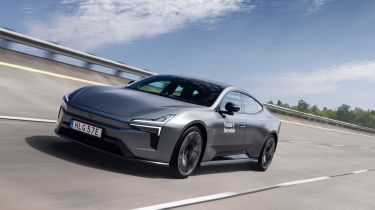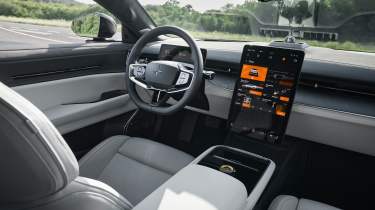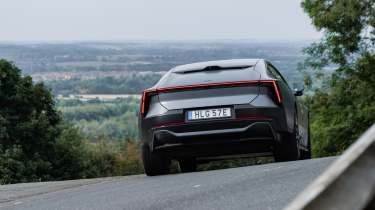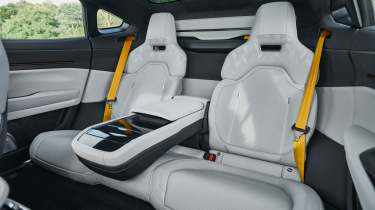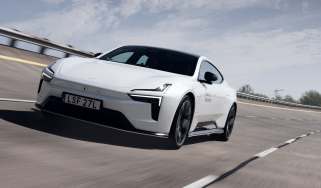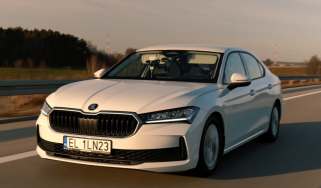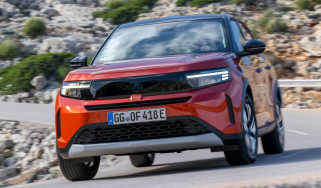New Polestar 5 is here: Porsche Taycan challenger pushes effortlessly cool Scandi design
Polestar’s UK-developed 5 is going to take the fight to the big players at the top of the premium performance EV class. Here’s what we know now…
The Polestar 5 has finally been revealed in its full production trim, with some eagerly-awaited technical specs confirmed, too.
When it reaches customers in the next few months, the electric car will cost from £89,500 for the Dual Motor Launch Edition and £104,900 for the Dual Motor Performance. These prices significantly undercut a Porsche Taycan model-for-model, and the Polestar largely beats it in terms of power and range, too.
In order to reach its sky-high benchmarks, Polestar has gone all out to design and develop its high-end electric GT from a blank sheet of paper. In fact, it’s not just the car that’s new, but the team behind it, the engineering facilities and even the plant it’ll be built in.
It’s a big gamble for Polestar, as it enters a market segment that’s seen sales slip in the past couple of years. Yet the Polestar 5’s die was cast some time ago, when the brand announced it would put its 2019 Precept Concept car into production. The hope will be that the newcomer can generate sales thanks to its sheer desirability, but there’s no denying it faces a tough task.
What are the numbers behind the car?
The Polestar 5 range will launch with two variants. Both share most of their technical elements, including a 112kWh battery and dual electric motor layout.
The entry-level Dual Motor will arrive first in a well-specified Launch Edition trim and cost from the aforementioned £89,500. This is slightly more expensive than a basic single-motor Taycan by around £1,300, but if you align the Polestar with the dual-motor 4S it’s £5,700 less, while significantly outperforming it across most key metrics.
Peak power is 737bhp – 147bhp up on the Taycan – 4S, while it comes with a WLTP range of 416 miles, up 16 on the Porsche. At 3.9 seconds from 0-62mph, the Polestar 5’s acceleration figure is two-tenths down, though.
The Dual Motor Performance pumps its power figure up to 871bhp, an identical figure to the Taycan Turbo. It will hit 62mph in 3.2 seconds, which is half a second down on the Turbo, but it’s also over £30,000 less at £104,900.
The Performance’s numbers falter slightly in terms of range, with a WLTP rating of 351 miles – some 40 miles down on the Turbo. There’s a number of reasons why this is the case, among the most prominent the performance-focused 21-inch wheels and tyres. Porsche’s Turbo figures are based on a less aggressive 20-inch wheel and tyre package.
Depreciation has been a big issue for the Porsche Taycan and there's currently plenty of choice of used cars available under £40,000 on the Auto Express Buy A Car service. Polestar will be looking to avoid a similar fate for three and four year-old Polestar 5s.
But the Polestar 5 is not just about numbers, right?
This is where things start to diverge between Polestar and Porsche. The 5’s chassis is totally bespoke to the brand, and has been developed in the UK by a team of engineers who have experience developing multiple generations of British sports cars.
That’s why the 5 uses a similar extruded aluminium structure to cars such as a Lotus Elise, which brings some significant benefits. Polestar is rightfully proud of the incredibly stiff structure, which has subsequently allowed it to keep the suspension and drivetrain relatively simple.
The suspension is double-wishbone all-round, and runs on coil springs with magnetic dampers as standard. There’s no rear-wheel steering, torque vectoring or limited-slip differentials, nor is there a two-speed transmission.
Polestar’s head of vehicle attributes Steve Swift told us: “We don’t have that type of technology because we just don’t need it. We’ve been able to design the fundamentals from scratch to do exactly what we want them to do, saving loads of time and complexity.”
The clever aluminium chassis does deliver one ironic stat – the Polestar 5 is around 250kg heavier than the Porsche. A bigger battery explains some of this, but its capacity is only up by a few kWh.
What do we need to know about the battery?
Polestar fits a 112kWh gross (106kWh net) NMC lithium ion battery that runs on an 800V electrical system. It quotes a peak charging speed of 350kW, with a 10-80 per cent battery top-up achieved in 22 minutes.
This is up on the Porsche in terms of pure peak kW, but the Taycan’s slightly smaller battery pack and more consistent charge curve means it will complete the 10-80 per cent charge time in 18 minutes. This is a claim we have tested at Auto Express, and we’ve found the Porsche capable of genuinely hitting these impressive figures in the real world.
What about the design and the cabin?
The Polestar 5’s lengthy, and quite public, development programme has made it a visible presence for the brand for a few years now – a risky move that could date it before it’s even on sale. However, this couldn’t be further from the truth, as the sleek silhouette and fine details still look razor sharp.
Although it looks angular in pictures, in the flesh you get a sense of the car’s curves and flared wheelarches, and see just how low it feels to the ground. The Polestar was always designed to work best on 21-inch wheels, but the optional 22-inch package on the Performance turns up the visual attitude.
However, it’s hard to ignore the fact that it does without a rear screen. While pre-production models had a plastic insert on the bootlid, as is the case with the current Polestar 4, the road-going 5 doesn’t – leaving a somewhat bizarre wobbly shutline.
The cabin is very similar to that of the Polestar 3, with an extremely clean design that is full of clever and thoughtful material choices. The digital interfaces are also shared, but they work well by combining an 11.2-inch vertical touchscreen with a fixed driver’s display up front.
All models come with a full-length glass roof as standard, and while there are five seats in total, Polestar calls it more of a 4+1 as the centre seat in the second row has limited headroom. However, the cleverest bit of the cabin isn’t the styling, but its packaging.
This is demonstrated by the rear seats, which feel far more spacious than the Taycan’s. Polestar has achieved this by moving the rear header rail further back, and by scooping out a row of the under-floor batteries to open up rear foot room. This is a technique also used by Porsche, but Polestar’s gone further by removing the entire width’s worth, rather than just by the outer seats.
The boot space is rated at 365 litres at the rear, with a bonus 65 litres up front. These are slightly down on the Porsche’s, nor can you order a Polestar 5 in an estate-like body style for more pet-friendly load lugging.
What else happened during development?
During the development of the Polestar 5, the team had two big obstacles to overcome. First, midway through the programme, the decision was made to change the battery chemistry, rendering a section of development as wasted time, even if the inherited knowledge has still proven useful.
The second is that former CEO (and car designer) Thomas Ingenlath insisted that the wheelbase be shortened only weeks before the overall design had to be locked in. This didn’t just change the length of the doors, but also forced designers to re-angle the windscreen and effectively redesign the entire technical package.
What was already a huge undertaking only grew, and this continued amid a backdrop of shrinking sales of key rivals such as the Taycan and Audi e-Tron GT. Poor sales of other similarly-sized cars, like the Lotus Emeya, and the cancellation of others, might also sound the alarm.
We have already driven the Polestar 5 in pre-production form, though, and can attest that it could and should be a game-changing EV. We’re seeing incredible innovation and development from European manufacturers in response to the rise of new brands – it’s encouraging to see that Polestar isn’t being left behind.
Come and join our WhatsApp channel for the latest car news and reviews...
Find a car with the experts

